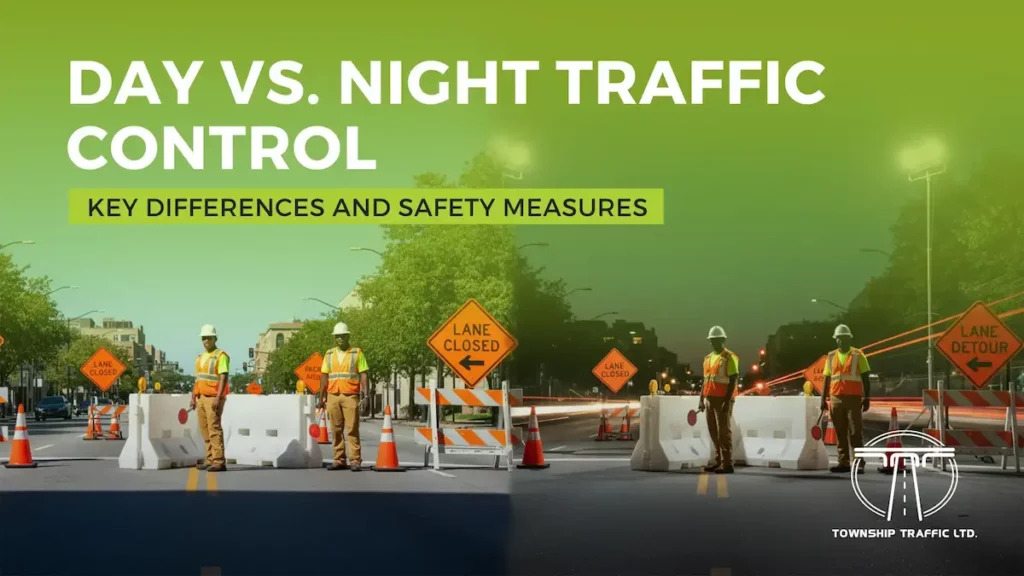Traffic control is one of the most critical aspects of maintaining safety on roads, highways, and construction zones across British Columbia. Whether work takes place during the day or at night, ensuring smooth traffic flow while protecting workers, drivers, and pedestrians requires proper planning, skilled flaggers, and reliable equipment. While the ultimate goal remains the same, safety first, the strategies for managing traffic during daylight hours can be significantly different from those applied at night.
In this blog, we’ll break down the key differences between day and night traffic control, highlight important safety measures for both scenarios, and introduce how Township Traffic, a trusted service provider in BC, ensures projects remain safe, efficient, and compliant with provincial regulations.
Why Traffic Control Matters in BC
The Fraser Valley and the rest of British Columbia are home to a rapidly growing population, expanding infrastructure projects, and busy transportation corridors. From road construction in Abbotsford to utility upgrades in Surrey and highway maintenance in Chilliwack, traffic control plays a vital role in reducing risks. Without professional management, roadwork zones can lead to accidents, traffic congestion, and unsafe conditions for both the public and workers.
That’s where professional traffic control providers, such as Township Traffic, step in—offering certified flaggers, advanced equipment, and tailored traffic management plans to keep every project running safely.
Day vs. Night Traffic Control: The Key Differences
1. Visibility Conditions
- Daytime: During daylight, visibility is naturally higher, which makes it easier for drivers to see signage, flaggers, and work zones. However, bright sunlight can create glare, which sometimes reduces driver reaction times.
- Nighttime: At night, visibility becomes the biggest challenge. Drivers rely heavily on reflective signage, cones, and lights to navigate work zones safely. Workers also face higher risks due to reduced driver awareness.
Solution: Night projects must use high-visibility clothing with reflective strips, illuminated signage, and adequate lighting to ensure clear communication with drivers.
2. Traffic Volume
- Daytime: Roads are busiest during daylight hours, especially during morning and evening rush hours. Managing large traffic volumes requires detailed planning, extended lane closures, and multiple flaggers.
- Nighttime: Night work usually encounters lighter traffic flow, which makes it easier to redirect vehicles. However, reduced traffic doesn’t eliminate risks—drivers at night are more likely to be fatigued or impaired.
Solution: Day projects need robust lane management, while night projects require strict enforcement of speed limits and increased driver awareness campaigns.
3. Safety Risks for Workers
- Daytime: The primary risks stem from distracted driving, high traffic volumes, and sudden lane changes. Workers must remain alert to avoid accidents caused by impatient or inattentive drivers.
- Nighttime: Night projects carry additional risks such as poor visibility, fatigue-related mistakes (both for drivers and workers), and higher chances of impaired driving incidents.
Solution: Training, proper scheduling, and rotating shifts can help keep workers alert and safe in both environments.
4. Equipment and Lighting Needs
- Daytime: Equipment such as cones, barriers, and signage is highly effective in daylight. Additional lighting is not typically necessary.
- Nighttime: Lighting towers, flashing arrow boards, and reflective devices are crucial. Without them, drivers may fail to notice a work zone until it’s too late.
Solution: Night projects require significant investment in lighting equipment and backup power sources to maintain safety.
5. Public Perception and Convenience
- Daytime: Drivers often complain about delays caused by daytime projects, especially during work commutes.
- Nighttime: While night work reduces inconvenience for drivers, nearby residents may face noise disturbances.
Solution: Clear communication with the public and advanced project notices help minimize frustration and maintain trust.
Essential Safety Measures for Day and Night Projects
Regardless of timing, both day and night traffic control require strict safety protocols. Here are some key safety measures:
- Certified Flaggers: Trained professionals who direct traffic and ensure safe passage for vehicles and pedestrians.
- Personal Protective Equipment (PPE): Workers must wear high-visibility vests, hard hats, gloves, and steel-toe boots.
- Clear Signage: Use of regulatory and warning signs that meet provincial standards.
- Traffic Control Plans (TCPs): Every project must follow an approved traffic management plan designed for the specific site.
- Lighting & Reflective Materials: Especially important for night projects, ensuring visibility from a distance.
- Speed Control: Speed reduction signs, radar boards, and police presence when necessary.
- Communication Tools: Two-way radios, whistles, and hand signals for seamless coordination among workers.
Why Choose a Professional Traffic Control Provider in BC?
Attempting to manage traffic without professional expertise puts lives at risk. A certified provider like Township Traffic offers the following advantages:
- Local Expertise: Deep knowledge of BC’s roadways, regulations, and worksite requirements.
- Certified Flaggers: Professionally trained staff equipped to manage complex traffic scenarios.
- Modern Equipment: Use of reflective signage, digital message boards, lighting towers, and safety barriers.
- Customized Solutions: Tailored traffic management plans to suit the unique needs of construction sites, utility projects, or community events.
- Commitment to Safety: Township Traffic Control prioritizes compliance with WorkSafeBC standards and industry best practices.
Whether it’s a road resurfacing project in Langley, a bridge repair in Abbotsford, or a pipeline installation in Chilliwack, Township Traffic ensures smooth operations and safe outcomes.
Conclusion
Day and night traffic control may differ in challenges and requirements, but their importance remains the same, protecting workers, drivers, and the community. Daytime projects demand strategies for handling high traffic volumes, while nighttime work requires enhanced visibility and safety measures.
By partnering with a trusted provider like Township Traffic, project managers across British Columbia can ensure their roadwork zones are secure, efficient, and compliant with provincial standards. Whether your project happens under the sun or the stars, professional traffic management is the key to safety.

